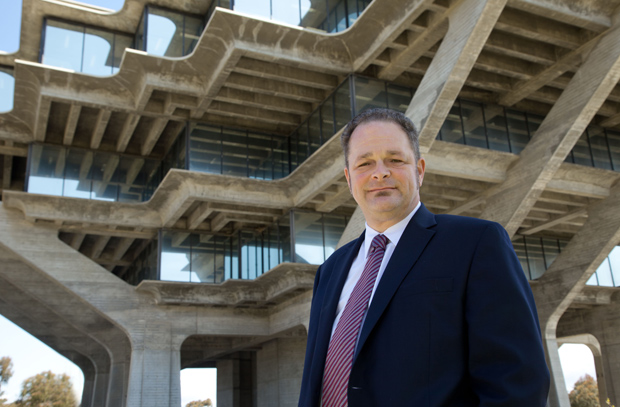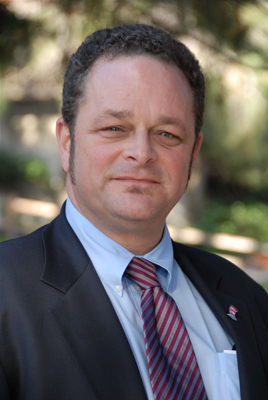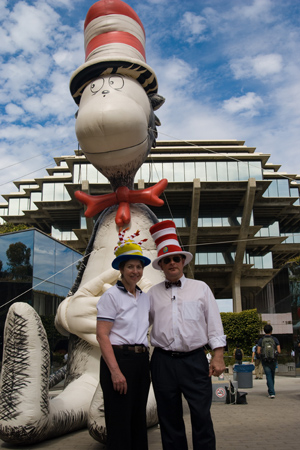
Published Date
Share This:
Q&A with Brian Schottlaender

Brian Schottlaender
Thousands of students, faculty, staff and community members use the UC San Diego Libraries every day. The Libraries provide more than 7 million digital and print volumes, journals and multimedia materials, and its resources and services are accessed on the Web almost 90,000 times a day. Ever-evolving shifts in user needs and the continuous decline in state funding, have led the Libraries to implement a number of changes, including the consolidation of some library buildings and collections. Brian E. C. Schottlaender, who joined the campus in 1999 as University Librarian and is the first holder of The Audrey Geisel University Librarianship, talks about the challenges and opportunities that come with organizational change, and how the Libraries will be transitioning over the next year.
For years, your organization was referred to as UC San Diego Libraries (plural). Why will you be changing that as you move forward with your consolidation efforts?
We have been consolidating our print collections, library facilities and services to accommodate our smaller footprint on campus. Along with that, we have begun to consolidate our organizational structure, which will take us from a decentralized, discipline-based organization to a leaner and more centralized operation. Basically, we are going from numerous libraries scattered across the campus to a single campus library offering a suite of services and resources from our two flagship facilities: the Geisel and Biomedical Library buildings, as well as our offsite storage annex and a smaller annex at the Scripps campus. As a result, over the next year, we will be transitioning to the UC San Diego Library (singular) from the UC San Diego Libraries. We believe this new name will better reflect our organization moving forward.
What was your thought process when you considered how to implement the Library’s budget cuts?
While having to absorb substantial budget cuts is never easy, the Libraries were fortunate to be engaged in strategic planning at about the same time we began having to implement cuts. We knew that we would have little choice but to consolidate our smaller and lesser-used facilities into our larger ones. Our goal was to do this strategically, and with a clear vision for how we would transform ourselves, to provide the campus with the high level of service and the quality academic resources needed to fulfill our academic mission. While we have become leaner, more efficient, and more focused as an organization, our role as essential contributors to UC San Diego’s academic, research, service and patient care successes remains our top priority.

What are the challenges you still face? What are the opportunities?
We face both short- and long-term challenges. In the short term, I am very concerned about additional budget cuts, given the fact that the State still faces substantial financial challenges. The Libraries have, since 2008/09, already absorbed an 18 percent reduction in our State funding, which, in turn, has resulted in a 13 percent reduction in our staffing and more than a $1 million reduction in our information resources budget. As a consequence, we are stretched very thin. Unfortunately, we are likely to face additional reductions.
In the long term, we need to continue to find and maintain an optimal balance between the electronic resources and the physical materials we provide for UC San Diego’s faculty, students and staff. While the bulk of our library users clearly show a preference for electronic resources and digital access, there are faculty and graduate students—especially in the arts and humanities and social sciences—who have a continuing need for materials, especially books, not yet available in digital form. We need to address their needs, as well as the needs of those who benefit from the availability of more electronic resources.
Finally, the cost of information resources continues to rise—inexorably and at rates well in excess of the consumer price index. As I noted above, the primary challenge is balance.
In terms of opportunities, the organizational restructuring of the Libraries, while difficult for some, is allowing us to reshape and re-imagine how we think about information resources and services, as well as how we make digital scholarly work and research data accessible to our users. These transformations will only lead to better services and resources for the campus. Our partnership with the San Diego Supercomputer Center on a series of Research Cyberinfrastructure (RCI) data curation pilots is an exciting opportunity for us to develop a new and essential suite of research data curation services for the campus. Faculty response has already been very gratifying.
How has your library space changed as a result of the consolidations?
We have been reshaping our physical space to more effectively meet the needs of our students and other users. Consolidating our collections has enabled us to add approximately 225 new seats and 125 workstations in Geisel Library. We have plans to add another 150 seats this summer. And the types of study and work space we are offering are not the same as they used to be. The academic library of today—including our own—contains computer labs, 24-hour study facilities, multimedia group study areas, and spaces for exhibitions, lectures and other activities. Specifically, we are planning to open a 24/5 study space (Sunday thru Thursday) in Geisel Library next fall, something our students have long wanted. We realize that students have lost critical study space on campus. However, the Libraries and the campus are doing our best to make up for that. [A list of campus study space can be accessed here.]

With the advent of the Internet and products like the Kindle, how are libraries keeping up with the times?
The UC San Diego Libraries have long been ahead of the technological curve, and we remain committed to maintaining that edge. We provide 24/7 digital access to more than 1.5 million e-books (and that number continues to climb dramatically); we purchase and make available more than 55,000 e-periodicals; and we have digital streaming rights for more than 28,000 films. We also have digitized about 188 of our collections, with plans to digitize many more. Our library mobile app is getting a lot of use, and we only see that usage growing, given the high rate of mobile device adoption on campus.
We’ve been recognized as innovative leaders in the development and management of digital resources to support the university’s research and teaching. The Libraries were the first academic library to partner with Google in its global book digitization project, which resulted in the digitization of more than 370,000 books from our collections. Also, we have played a leadership role in HathiTrust—I have served on the executive board since its inception in 2008. HathiTrust, a vast digital repository that currently contains more than 10 million books, is an international partnership of 52 academic and research libraries that are committed to long-term digital preservation to support research and teaching.
Do you think there will always be a demand for libraries and hard-copy reading materials?
Yes, I do—in the same way that there is still a demand for radio, theater and television, I think there will always be a demand for hard-copy books, although the demand is shrinking and will be a lot more focused. Of course I’m biased, but I think the need for libraries remains stronger than ever. When people are deluged with information, they more than ever need librarians—who are information experts. At the risk of stating the obvious, Google and Wikipedia are fine for gathering quick information, but if you are conducting evidence-based research, they are simply not sufficient. I think what the author Neil Gaiman said sums things up pretty accurately: “Google can bring you back 100,000 answers; a librarian can bring you back the right one.”
Fun Faves
Favorite place at UC San Diego: The Voigt Drive hill with Bruce Nauman’s Vices and Virtues, and the Geisel Library on your left and the eucalyptus grove on your right.
Favorite place on Earth: London
Favorite book: Infinite Jest by David Foster Wallace
Favorite library: Geisel Library, of course. The Berg Collection at the New York Public Library is a close second.
Favorite hobby: I’m a collector. I collect books, records, stamps and the works of William S. Burroughs.
Favorite food: Coffee
Favorite technology/gadget: My ThinkPad X201
Favorite way to spend $10: Taking my wife out for coffee
Favorite words to live by: “What did you learn?”
Share This:
You May Also Like
Stay in the Know
Keep up with all the latest from UC San Diego. Subscribe to the newsletter today.


